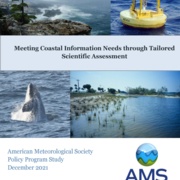Executive Summary
Weather, water, and climate issues underpin virtually every aspect of society. Although all communities face multiple complex challenges and opportunities relating to weather, water, and climate, coastal communities are often at the forefront. Coasts are valuable resources that support numerous ecological, social, and economic systems around the United States and the world; however, they are subject to increasing levels of disruption and risk due to ongoing and interconnected changes in climate and human development.
Driven by advances in Earth system observations, science, and services (OSS), as well as technological developments, weather, water, and climate information is increasingly available and reliable. However, for this information to most effectively support the long-term resilience of coastal communities it must also be actionable. As such, there is a tremendous opportunity to employ science more effectively by focusing on stakeholder needs and the decisions those stakeholders must make in the near term and by bringing communities into the process of advancing and applying scientific understanding.
In this study, part of an ongoing pilot program on actionable scientific assessment, we identify three overarching findings and four key areas of information needs applicable to coastal resilience-related decision-making. These findings stem from dialogues with decision makers, resilience practitioners, information providers, and other stakeholders from two U.S. coastal regions—the Gulf of Maine and the Gulf of Mexico—along with additional analysis.
Findings:
- Individuals of all backgrounds and levels of engagement with climate change discourse may benefit from weather and climate information;
- The resilience challenges faced by coastal communities are inherently location-specific; local-scale information is generally necessary but not sufficient to address these challenges. Contextualization as well as appropriate technical support are each vital to the uptake and use of data and other information resources;
- Partnerships of all types, including those between local, regional, state, and federal levels of government and those between public, private, academic, and non-governmental organizations, are a necessary mechanism to support coastal communities in addressing decision making challenges and advancing resilience efforts.
Key information needs:
- Information to improve the prediction of impacts from hazards such as sea level rise and flooding events, and their interactions. How should prioritization of targets for relocation, protection, restoration, or acquisition take place? How should a community update its building codes or infrastructure design standards to account for changes in climate?
- Information to understand and communicate the value of marine processes and ecosystem services. How will local ecosystem changes affect marine industries? What are the thresholds and tipping points beyond which key species cannot thrive?
- Information to enable the holistic evaluation of adaptation efforts. Which measures or practices should a community invest in to maximize resilience? What are the costs (environmentally, socially, and economically) of doing nothing? When and how should a community consider managed retreat?
- Information to enable visualization. What might the coast look like in 10, 20, 50, or 100 years? How can communities communicate their visions of the future and collaborate to produce innovative solutions?
Future weather and climate science is likely to be well equipped to provide decision makers with increasingly local information relating to a number of coastal issues, including evaluation of the benefits of adaptation measures such as nature-based solutions; physical, chemical, or biological thresholds and tipping points; and improved prediction of impacts from complex problems. However, delivering this information effectively will almost certainly depend on breaking down traditional disciplinary silos and including insights from throughout the social sciences. Assessments might also utilize a range of timescales in order to promote visualization efforts and present information in a common format to promote inter-municipal collaboration and partnership at all scales.
The complexity of the decision-making landscape means that it is unlikely that any one climate assessment will be able to address the needs of all parties in a municipality or region. A suite of assessments may aid in minimizing uncertainty across the spectrum of decision-relevant values within coastal communities, and, indeed, for all communities and information sectors. However, it is also important for these assessments to work as part of an iterative process. Although “perfect” information will never be available for decision making, a feedback loop between researchers and communities can help create increasingly better assessments and prioritize community action (i.e., which topics of interest are likely to be further informed by future research and which are currently at the limits of scientific knowledge).
Long-term resilience will almost certainly depend on collaboratively filling in knowledge and communication gaps both within and beyond Earth system OSS, in conjunction with broadly available financial and technical support. Federal agencies such as NOAA can continue to promote publicly available datasets and help develop cross-agency standards for processes such as benefit–cost analysis that play a large role in community decision making. Additionally, dedicated collation of available public tools into an easily navigable format, such as an interactive guide, may help less-experienced users target the climate information most applicable to their specific circumstances. Other information providers, particularly those in the private, academic, or nonprofit sectors, have the potential to play a key role in decision support through interpreting information or providing clearinghouses for best or promising practices. In the face of a deluge of climate information and an expanding climate workforce, organizations such as the American Meteorological Society (AMS) may play a role through helping to ensure that the information and models offered to decision makers is credible, for example by developing a program to certify climate information providers.
